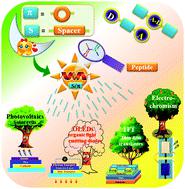当前位置:
X-MOL 学术
›
J. Mater. Chem. C
›
论文详情
Our official English website, www.x-mol.net, welcomes your feedback! (Note: you will need to create a separate account there.)
Peptide-based novel small molecules and polymers: unexplored optoelectronic materials
Journal of Materials Chemistry C ( IF 6.4 ) Pub Date : 2021-08-25 , DOI: 10.1039/d1tc03375a Rajamouli Boddula 1 , Surya Prakash Singh 1, 2
Journal of Materials Chemistry C ( IF 6.4 ) Pub Date : 2021-08-25 , DOI: 10.1039/d1tc03375a Rajamouli Boddula 1 , Surya Prakash Singh 1, 2
Affiliation

|
In recent times, optoelectronic materials have become emerging technology and several designs have been established to overcome the past failures and desire for new efficient devices. Numerous analyses employing imidazole, carbazole, triphenylamine, phosphine oxide, squaraine, BODIPY, dithienosilole, dithienogermole, and fullerene/non-fullerene derivatives have been developed in different donor–acceptor combinations with the inclusion of pi/spacer conjugations. Most of these designs are constructed by organic, organometallic, and solid-state (or hybrids) to improve the external quantum yield, lifetime, and color saturation. Recently, few bio-molecular materials (peptide-conjugated) have attracted attention due to the screening of their electronic and luminous properties. Peptide-based conjugate molecules are a promising class of soft materials, which are currently gaining importance among the material community due to a wide range of applications (protein therapeutics, drug delivery, optoelectronics, and catalysis). However, peptide-based materials are currently a focused area of study since inadequate results are available and it is required to increase interest in the field with peptides as the main focus in optoelectronics. The current review explains optoelectronic materials based on peptides moieties, which have unexplored applications due to fewer reports on them. In optoelectronics, photovoltaics (solar cells), organic light-emitting diodes (OLEDs), thin-film transistors, and electrochromism have been discussed. Photoactive materials design based on the donor and acceptor concept has been presented and discussed. This evaluation contributes to the materialistic properties of the peptides for electro-optic applications and their design strategy along with the current status. The discussion on the future perspectives of optoelectronics via peptide-based materials will certainly give an insight into the new upcoming trends.
中文翻译:

基于肽的新型小分子和聚合物:未开发的光电材料
近年来,光电材料已成为新兴技术,并且已经建立了多种设计来克服过去的失败和对新高效器件的渴望。使用咪唑、咔唑、三苯胺、氧化膦、方酸菁、BODIPY、二噻吩并噻吩、二噻吩并二噻吩和富勒烯/非富勒烯衍生物在不同的供体-受体组合中进行了大量分析,其中包括 pi/spacer 共轭。这些设计中的大多数是由有机、有机金属和固态(或混合)构成的,以提高外部量子产率、寿命和颜色饱和度。最近,很少有生物分子材料(肽偶联物)由于其电子和发光特性的筛选而引起关注。基于肽的共轭分子是一类很有前途的软材料,由于广泛的应用(蛋白质治疗、药物输送、光电子学和催化),它们目前在材料界越来越重要。然而,基于肽的材料目前是一个重点研究领域,因为可用的结果不足,需要增加对该领域的兴趣,以肽为光电子学的主要焦点。目前的评论解释了基于肽部分的光电材料,由于对其的报道较少,因此其应用尚未开发。在光电子学中,已经讨论了光伏(太阳能电池)、有机发光二极管(OLED)、薄膜晶体管和电致变色。已经提出并讨论了基于给体和受体概念的光敏材料设计。该评估有助于了解用于电光应用的肽的物质特性及其设计策略以及当前状态。光电子学未来前景探讨通过基于肽的材料肯定会深入了解即将到来的新趋势。
更新日期:2021-09-16
中文翻译:

基于肽的新型小分子和聚合物:未开发的光电材料
近年来,光电材料已成为新兴技术,并且已经建立了多种设计来克服过去的失败和对新高效器件的渴望。使用咪唑、咔唑、三苯胺、氧化膦、方酸菁、BODIPY、二噻吩并噻吩、二噻吩并二噻吩和富勒烯/非富勒烯衍生物在不同的供体-受体组合中进行了大量分析,其中包括 pi/spacer 共轭。这些设计中的大多数是由有机、有机金属和固态(或混合)构成的,以提高外部量子产率、寿命和颜色饱和度。最近,很少有生物分子材料(肽偶联物)由于其电子和发光特性的筛选而引起关注。基于肽的共轭分子是一类很有前途的软材料,由于广泛的应用(蛋白质治疗、药物输送、光电子学和催化),它们目前在材料界越来越重要。然而,基于肽的材料目前是一个重点研究领域,因为可用的结果不足,需要增加对该领域的兴趣,以肽为光电子学的主要焦点。目前的评论解释了基于肽部分的光电材料,由于对其的报道较少,因此其应用尚未开发。在光电子学中,已经讨论了光伏(太阳能电池)、有机发光二极管(OLED)、薄膜晶体管和电致变色。已经提出并讨论了基于给体和受体概念的光敏材料设计。该评估有助于了解用于电光应用的肽的物质特性及其设计策略以及当前状态。光电子学未来前景探讨通过基于肽的材料肯定会深入了解即将到来的新趋势。



























 京公网安备 11010802027423号
京公网安备 11010802027423号